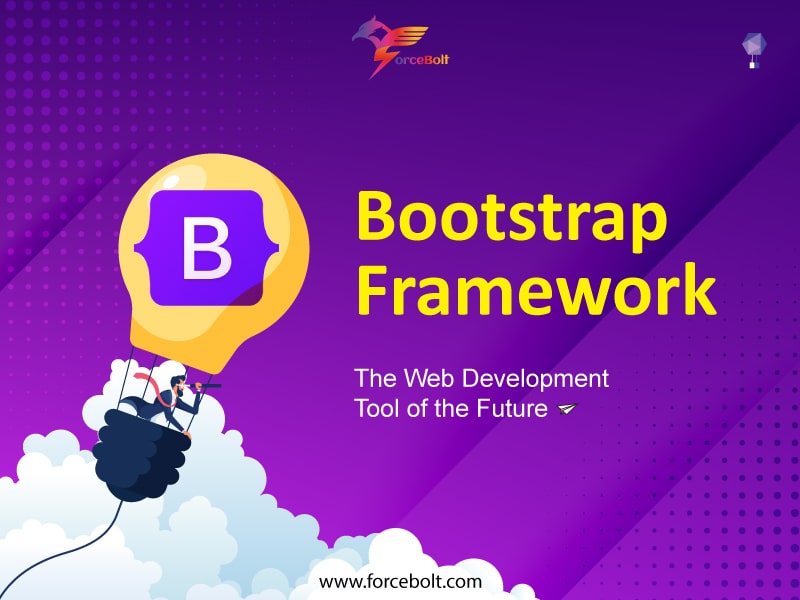Sharing is caring!
The web design and development sector has gradually started to experience a significant growth spurt in an era marked by the advent of the digital revolution. Most people and businesses have begun to roll out web-enabled applications to communicate with users who are spread across various browsers, devices, and platforms.
Therefore, it is even more crucial to streamline the methods and tools used to support front-end development. But as technology advances, the world of web development is changing every day.
There are now constant introductions of new programmes, better codes, and superior functions. How can a web developer ensure the user experience is not harmed in such a situation? How can web designers ensure that their site is consistent, seamless, and accessible regardless of the device used to view it?
The highly customizable and feature-rich Bootstrap framework was explicitly created to address problems like these. For developers creating responsive websites and web applications, Bootstrap is a surprisingly helpful tool.
As a mobile-first web development framework, Bootstrap was introduced. With a market share of more than 21% of all websites, it is currently one of the most streamlined responsive front-end frameworks.
For those unfamiliar, development frameworks are independent starter themes that provide a standard set of pre-built yet tailor-made features and functions to hasten the development of a website or application.
Why Use Bootstrap Framework For Responsive Web Design?
Even though using a framework to create a responsive website is optional, doing so can speed up and streamline the development process.
Here are some methods a framework like Bootstrap can assist you with creating responsive websites because you can repurpose the code within a framework and avoid repetitive actions.
- Utilize pre-built responsive grid options to get the most out of responsive design concepts.
- Make minor layout adjustments to your projects to add consistency.
- Create quick prototypes of designs with the aid of a starter theme.
- Ensure consistency among developers engaged in the same project.
Even though there are many cutting-edge and effective front-end frameworks on the market right now, Bootstrap is the front-runner among developers for building responsive websites, according to Google Trends, which is why bootstrap development services are booming everywhere.
Bootstrap is responsive for all types of projects; here are a few of the key factors that make it suitable:
- Mobile First Approach
Bootstrap uses a unique “mobile-first” strategy in addition to being fully responsive to assist you in creating responsive, mobile-friendly websites. This method requires web designers to develop a website for mobile devices before scaling the design up to render on large screens.
This design strategy, also known as progressive enhancement, enables you to comprehend and satisfy the most fundamental needs of your mobile users, which is arguably the first step in creating a responsive website correctly.
- Powerful Grid System
Bootstrap includes a fluid 12-column flexbox-based grid system that scales up or down automatically depending on a device’s screen resolution. This grid system is based on the flex display property and allows you to display any content type in a fully customizable, responsive grid. The entire process of developing responsive designs is simple with Bootstrap.
You can use the 12 columns separately or combine them to make wider columns. Additionally, thanks to its responsive utilities, you can quickly hide or show a specific section of content on particular screen size.
- Pre-Styled Components that are Built-in
Bootstrap includes everything you might need to create a fully responsive website, which is another crucial factor in why people prefer it to other front-end frameworks.
It comprehensively includes all the elements a developer typically needs to code from scratch when creating a responsive site, from responsive typography and menus to reusable CSS and JavaScript libraries.
Additionally, you can purchase a pre-built Bootstrap template and modify it to suit your unique requirements to expedite the development of your responsive website even more.
What’s New in Bootstrap?
The most recent version of Bootstrap is Bootstrap 4. It is utilized to create web UIs. It includes a set of free resources that can be used to create websites and web applications. It has optional JavaScript extensions and many templates and classes for navigation, buttons, forms, typography, and other interface elements.
It is frequently referred to as the CSS Framework’s hero and is primarily used for responsive design. You can use or not use the reusable components and jQuery plugins included with Bootstrap. You always have complete control with Bootstrap.
The most recent version of Bootstrap is Bootstrap 5, which has undergone a smooth redesign. However, jQuery is replaced with standard JavaScript and Internet Explorer 11, and lower are not supported. Many colossal organisations use Bootstrap, including Twitter, Spotify, Udemy, LinkedIn, and 40,000+ companies.
What’s The Future of Bootstrap?
The significance and value of the Bootstrap framework will only grow with time. This framework is highly likely to be used across numerous business verticals because it makes it easy for designers and developers to create websites. The ability to seamlessly integrate, assimilate, and construct will undoubtedly be a strength of the Bootstrap framework when this expanded scope is combined with a futuristic approach.
Bootstrap has lived up to the expectations of every developer, and the recent improvements have just uplifted the game of this framework more than ever. Since Bootstrap is backed by a great team and huge companies are using it, Bootstrap is seeing a bright future, and demand for hiring Bootstrap development services will increase.
If you are looking to hire high-quality and cost-effective Bootstrap development services, ForceBolt is the one-stop solution for all your development needs. To know how ForceBolt can help you grow your business, get in touch with us today!

Akshay Dhiman
Chief Technical Officer
The Chief Operating Officer of ForceBolt and a decisive leader who possesses a wide array of technical skills and management skills to implement operational changes by working at different levels of development. Being enthusiastic and technology proficient, he understands the importance of staying up-to-date with the latest technological transformations and provides competitive, scalable and efficient solutions. He has a good command of technical language and possesses good communication skills. Being a leader makes him a good team player, and he resonates with his priorities well.












